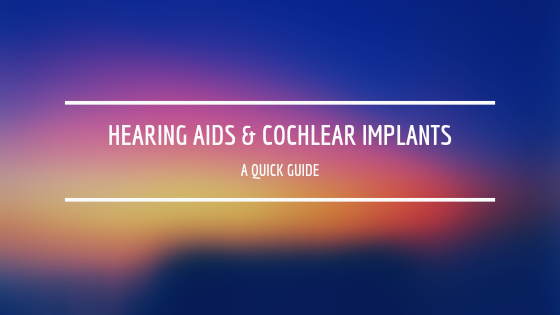Why Compare Hearing Aids and Cochlear Implants?
Being diagnosed with hearing loss at any age can be difficult to cope with. This usually happens after a visit to the GP and their referral to your local hospital audiology department. The good news is there’s plenty you can do once you have been told your hearing is failing.
Hearing loss occurs for a variety of reasons – for some it can be the result of a traumatic event, for others it may be a gradual decline that is linked to ageing or illness.
There is a lot of help out there nowadays and the technology for hearing aids and cochlear implants has improved dramatically over the last decade or so. Today’s top of the range hearing aids are a lot less obtrusive than they used to be. They also have very advanced features, some of which may surprise you. Cochlear implants are almost unrecognisable from just a few years ago, with commensurate improvements in the ability to hear well, such that most recipients achieve hearing abilities which almost match that of a hearing person.
With a bewildering variety of hearing devices, it can be difficult to work out which one will work best for you. In order to make the most of your residual hearing, you want the hearing device that most closely meets your needs. Your first step is to visit an audiologist, who will assess your hearing and recommend the best device for you. In this article, I’ll compare hearing aids and cochlear implants in a basic way, just to get you started and to familiarise you with what is available.
Compare Hearing Aids
When we compare hearing aids, the first thing you need to realise is there are a few different categories. A lot will depend on your hearing diagnosis and how severe it is, whether you want a NHS supplied aid or wish to go to a private hearing aid dispenser, and how much you would like to pay.
Most people rate the top hearing aids on the basis of how effective they are. Some are big but obvious, others are small but kind of fiddly. You’ll want to consider battery life and how often you are prepared to change them. Most of all, when you compare hearing aids, you want to pay attention to the advantages and disadvantages of each type.
1. Behind the Ear (BTE)
This is probably what most people recognise as a conventional hearing aid. A small plastic section sits behind the ear connected to a tube and ear mould that fits like a small headphone. These styles come in a range of colours and are slightly smaller than models in the past. If you are not bothered about the hearing aid being visible, this is a good choice and easy to use.
2. Receiver in the Ear (RITE)
These are similar to the BTE model but a lot smaller and connected to the ear piece by a slim wire. While they are less obtrusive, they are also a little more fiddly to put on.
3. In the Ear (ITE)
These fit directly into your ear and can be seen from the side but aren’t visible from the back or front. Again they can be a little difficult to put in if you don’t have the most dextrous fingers in the world. The battery can be difficult to change as it is so small.
4. In the Canal (ITC)
ITC hearing aids are smaller and less visible than ITE varieties. Although the technology has improved over the last few years, these are generally not as powerful as other aids and are therefore not suitable if you have more severe hearing loss.
5. Completely in the Canal (CIC) & Invisible in the Canal (IIC)
These are very small hearing aids and fit snugly in the canal area. The trouble is that they can be difficult to put in and almost impossible to take out without the help of a hearing specialist. As with the ITC aids, they are not as powerful as the larger products on the market today.
6. CROS & BiCROS
This is a slightly more unusual combination and used when you have hearing loss in one ear. It consists of two hearing aids. The one from the damaged ear takes the sound and feeds it to the aid in your good ear. The two sections are connected by a wire that hangs around the nape of the neck.
Find out more about hearing aids at Hearing Aid Know.
Cochlear Implants: The Final Frontier
Hearing aids don’t work for all circumstances. A cochlear implant is an electronic device that basically replaces the natural functioning of your inner ear. An external device behind the ear sends a digital signal to an electrode array fitted into the inner ear. This in turn transmits that information to the brain, to give the sensation of sound. Over time, with plenty of listening practice, your brain learns to interpret the signals into wonderful sounds and a very natural, almost normal, sense of hearing.
Cochlear implants are more invasive than standard hearing aids and are usually reserved for those with severe to profound hearing loss. Most people who have had an implant report that they hear better than with any other hearing aid and are able to focus better, particularly when there is a lot of noise around. It also makes lip reading easier and general communication is much less of an effort.
There are four brands of cochlear implants. They do have their differences and you should have a careful discussion with your audiologist and surgeon to discuss which one is best for you. This comparison chart will be very useful in your research as it offers an impartial in-depth overview of all the features of cochlear implants. Doing your research is important as, once you have the electrode array implanted, you can’t just remove it and change it for another brand. Your implant will be inside you for several years and you want to ensure it meets your particular requirements.
I was initially terrified of getting a cochlear implant but I love my bionic hearing now. In fact, I told my surgeon that he could add a third one – if he could find somewhere to put it! My own cochlear implant journey is explored at Funny Old Life.
Find out more about cochlear implants at Cochlear Implant Help.
Compare Hearing Aids and Their Prices
When you are looking to compare hearing aids, your first choice is using the NHS or going private. The former gives you a limited selection compared to the latter but you get the hearing aid free as a lifetime loan and you get replacement batteries and repairs done for free.
If you opt for a private hearing aid provider, you will have to pay for the hearing aid and the cost of these can vary considerably. You could end up paying anything between £600 and £2,200 depending on the company you go to and the features you want or need. You may want to compare hearing aids available in other countries such as India which are considerably cheaper yet offer world class hearing care and facilities.
One of the key things is to make sure that you try the hearing aid first and find out how well it works for your hearing, even if this is just a walk down the street. Take a friend with you and have a conversation – how does that sound? Some hearing aids are better than others and deliver higher quality sound. Some hearing aids allow you to choose programmes for different hearing environments, such as when it is noisy, so check these out as well.
If you’re paying for the hearing aid, take your time and ensure it’s the right product for you. Don’t just base your choice on the aesthetic appeal. Look at how easy it is to use if you need to change the battery, it is comfortable in your ear, does it help your hearing loss, how does the environment sound to you, can you hear better when someone is speaking to you.
Find out more about digital hearing aid prices at Hearing Aid Know.







Leave a Reply
Want to join the discussion?Feel free to contribute!